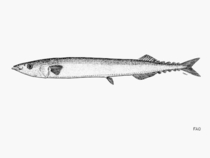Pacific saury
It is known as sanma in Japanese, kongchi in Korean, qiu dao yu in Chinese, and saira in Russian.

Original source: ja:Image:Sanma01.jpg
Author: Miya
Permission: GNU Free Documentation License
The Pacific saury lives in the pelagic-oceanic, oceanodromous, marine, depth range 0 - 230 m environment.
Pacific Saury - Harbinger of Autumn
 The Pacific saury (Cololabis saira) is a fish that is found in schools in the North Pacific from Alaska, down to Mexico and across to Japan and Korea. Long and slender, it's considered a member of the needle fish family. The Pacific saury can grow to about 40 cm or 16 inches long and weigh about 180 grams or 6.3 ounces, though it usually grows from 25 to 28 cm or 9.8 to 11 inches. It's happiest in water temperatures from 15 to 18 degrees C, or 59 to 64 degrees F. The saury lives no more than two years. The eggs are fertilized externally and use filaments to attach to each other and other objects that drift in the sea. The parents don't guard the eggs, and many of them are eaten by other animals. However, the Pacific saury is a resilient and prolific fish and its population can still double in a little over a year.
The Pacific saury (Cololabis saira) is a fish that is found in schools in the North Pacific from Alaska, down to Mexico and across to Japan and Korea. Long and slender, it's considered a member of the needle fish family. The Pacific saury can grow to about 40 cm or 16 inches long and weigh about 180 grams or 6.3 ounces, though it usually grows from 25 to 28 cm or 9.8 to 11 inches. It's happiest in water temperatures from 15 to 18 degrees C, or 59 to 64 degrees F. The saury lives no more than two years. The eggs are fertilized externally and use filaments to attach to each other and other objects that drift in the sea. The parents don't guard the eggs, and many of them are eaten by other animals. However, the Pacific saury is a resilient and prolific fish and its population can still double in a little over a year.
Like many fish, the Pacific saury is darker on its dorsal or topside than it is on its bottom. On top, its color ranges from dark green or blue and its belly is silver with blue spots, a color scheme that might hide them from predators above and hide them from potential prey. Like the tuna, it has tiny finlets near its tail. The Pacific saury lives near the shore as an adult but younger fish live among mats of floating seaweed, very much like young fish in the Sargasso sea half a world away. The saury eats plankton and the eggs and larvae of other fish and is in turn prey for whales, dolphins, sharks and larger fish, and will try to escape them by just skimming the surface of the water.
Pacific saury are an important food fish in Asia, and it's fished much the way anchovies are. Fisherman go out in the dark and shine bright lights from their boats. The fish believe the lights are the moon and swim towards them, where they're caught in nets. In Japan many foods are considered seasonal and Pacific saury is considered a food served in autumn. It's served grilled with the skin on, with a grated white radish called daikon, with some salt and soy sauce. It's also cooked in aluminum foil with chestnuts, gingko nuts, mushrooms and lemon, or cooked and served with a sauce made of ginger, dashi or soup stock, sake, red miso bean paste and scallion. In the west, Pacific saury is used largely as pet food or fertilizer.
Picture of the Pacific Saury by Miya, licensed under Creative Commons Attribution-Share Alike 3.0 Unported license.
Common names
Agulhao-do-Japao in Portuguese (Português)
Balaou du Japon in French (français)
Balaou du Pacific in French (français)
Balaou japonais in French (français)
Cololabis saira in French (français)
Kurzschnabelmakrelenhecht in German (Deutsch)
Mackerel pike in English
Mackerel-pike in English
Orphie in French (français)
Pacific saury in English
Paparda del Pacifico in Spanish (español)
Parpada del Pacífico in Spanish (español)
Saira in Finnish (suomen kieli)
Saira in German (Deutsch)
Saira in Polish (polski)
Saira in Russian (русский язык)
Saira in Swedish (Svenska)
Samma in Austronesian (Other)
Samma in Carolinian
Samma in French (français)
Sanma in Japanese (日本語)
Sauri in Spanish (español)
Sauri pasifik in Indonesian (Bahasa Indonesia)
Saurie in French (français)
Saury in English
Saury in French (français)
Skipper in English
Stillehavsmakrelgedde in Danish (dansk)
сайра in Russian (русский язык)
Сайра тихоокеанская in Russian (русский язык)
サンマ in Japanese (日本語)
秋刀魚 in Mandarin Chinese
秋刀鱼 in Mandarin Chinese
꽁치 in Korean (한국어)


Original source: FishBase
Permission: Some rights reserved
Family : Scomberesocidae
Genus : Cololabis
Species : Cololabis saira
Authority : Brevoort, 1856
